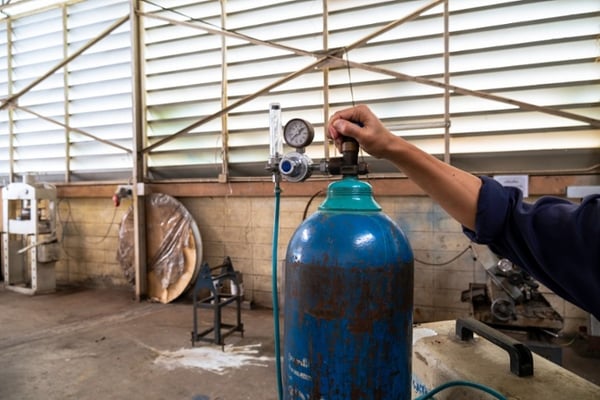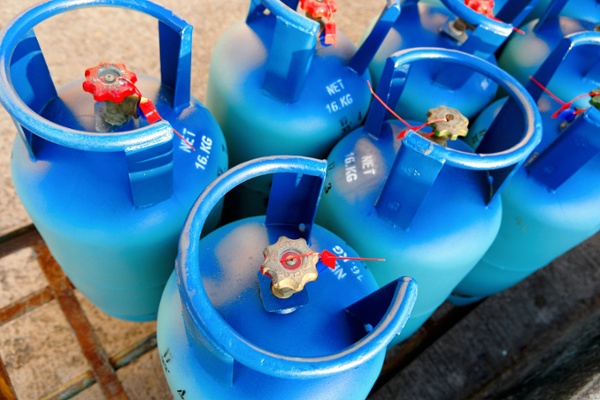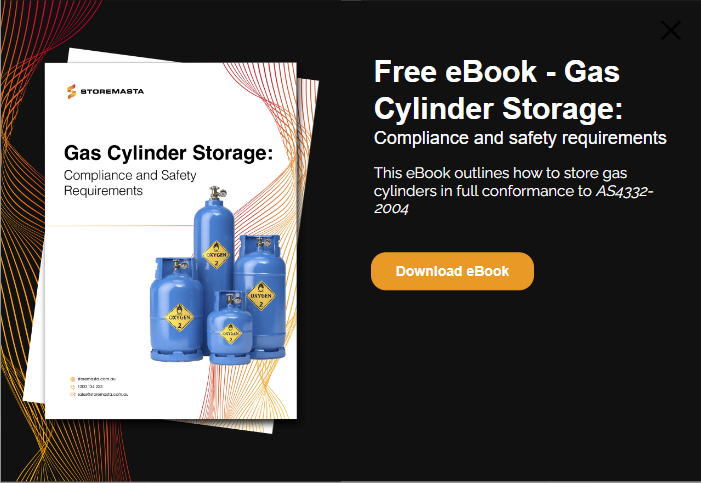You’re probably aware of the hazards associated with gas cylinders in the workplace — but did you know that empty gas cylinders can also create dangerous situations in the workplace? In this post, we’ll look how to handle and store empty gas cylinders, how to dispose of gas cylinders and the ways in which you can improve gas cylinder safety in your own operations.
Key Risks When Working with Gas Cylinders or Gas Bottles
Gas cylinders pose various risks, and mishandling or improper use can lead to serious consequences.
Some of the common risks associated with these Class 2 dangerous goods include:
Pressure Hazards: Gas cylinders contain compressed or liquefied gases under high pressure. If the cylinder is damaged or compromised, it can rupture, leading to the release of a large amount of gas at high velocity.
Physical Hazards: Gas cylinders are heavy and can cause injuries if mishandled. Dropping or improperly securing a cylinder can lead to accidents, such as crushing or pinning injuries.
Health Hazards: The properties of the gas stored within the cylinder can create health hazards for the users of these dangerous goods. Gases may be flammable, toxic or corrosive – which can impact the health and safety of staff handling these goods.
Chemical Incompatibility: Mixing incompatible gases in a single cylinder or storing cylinders of different gases together can lead to chemical reactions, resulting in hazardous situations, such as the formation of corrosive or toxic compounds.
Fire Hazards: Some gases are flammable, and if released in the presence of an ignition source, they can lead to fires.
Are Empty Gas Bottles Dangerous?
When you’re working with dangerous goods, such as Class 2 gases, it’s important to remember that the container that your chemical is stored in may have residue left over – even when you think the vessel is ‘empty’.
While the level of risk is lower, the residue can still create the same problems as a full gas cylinder. Therefore, gas bottle safety requires diligent monitoring of all storage and handling procedures, so you can make sure that your staff and your property remain free from danger – regardless of the quantity of gas left in your cylinder.
REMEMBER: Over time, these metal gas cylinders may corrode, especially if not properly maintained. Corrosion weakens the structural integrity of the cylinder, increasing the risk of leaks or ruptures.
Can Empty Gas Cylinders Explode?
Empty gas cylinders still pose risks, although the likelihood of an explosion is significantly reduced compared to a filled cylinder.
Here are some considerations regarding empty cylinder fire and explosion hazards:
Residual Gas: Even when a gas cylinder is deemed empty, there may still be residual gas or vapours remaining. This residual gas can be flammable or reactive, depending on the type of gas that was originally stored in the cylinder. In some cases, the remaining gas can pose a risk of explosion if exposed to ignition sources.
Pressure Hazards: While an empty cylinder is not pressurised with the same force as a full one, there may still be some residual pressure. Mishandling or damaging an apparently empty cylinder could potentially release this residual pressure, leading to safety hazards.
Inert Gases: Some cylinders are used to store inert gases that are not flammable. While the risk of explosion is low in these cases, there may still be considerations for handling and storage, as well as the potential for other safety hazards.
There have been many accidents in the workplace – or during the waste disposal process – simply because staff are unaware of the dangers associated with their seemingly empty gas cylinders.

It is difficult to know how much gsa is left in a cylinder, but all cylinders considered 'empty' must be managed the same way as if they are full as hazards still exist.
If a cylinder is disposed of incorrectly – or kept near ignition sources, punctured or exposed to incompatible dangerous goods – the cylinder can react in a similar manner to a full cylinder. This can mean that fires, health hazards and property damage are likely scenarios if gas bottles or cylinders aren’t treated with the care and attention required during the transport, storage or disposal process.
Importance of Safe Gas Storage and Handling
To mitigate these risks, it is crucial to follow proper handling, storage, and transportation procedures for gas cylinders. This includes using appropriate equipment, securing cylinders in an upright position, avoiding damage to valves and regulators, and ensuring proper ventilation in areas where gas cylinders are stored or used.
Training and awareness among individuals handling gas cylinders are also essential to control the risks associated with their use. By creating procedures and protocols for the handling and storage of your empty gas cylinders, you can ensure that all staff are aware of the hazards associated with these empty vessels.
How to Store Empty Gas Cylinders
Empty cylinders should be treated in the same way as full cylinders; that is, ensuring that they are:
- Kept in their own dedicated store
- Cool and well-ventilated
- Properly secured and restrained
- Isolated from ignition sources, heat and direct sunlight
- Kept away from other incompatible dangerous goods
- Accurately placarded with DG diamonds and hazard signage
- Stored away from boundaries and protected places
We recommend using a ready-to-install gas cylinder cage to store your empty gas cylinders. These gas cages are made to Australian Standards and offer the necessary protection to minimise when storing empty cylinders or gas bottles.
DID YOU KNOW Segregation for gas cylinder stores, whether the cylinders are empty or full, includes the segregation of Class 2.1 gases from Class 2.3 or Class 2.2/5.1 gases by at least 3 metres? Also, any known reactivity between mutually incompatible gases within a class, subclass or subrisk must be taken into account when segregating.
Tips for Handling Empty Gas Cylinders
To safely handle empty gas cylinders:
- Personal Protective Equipment: Continue to wear the correct personal protective equipment for your gas class when handling gas cylinders. You’ll find the correct PPE requirements in your safety data sheet for each type of cylinder onsite.
- Labelling: Clearly label cylinders to indicate that they are empty and specify the type of gas that was originally contained in them.
- Ventilation: Ensure proper ventilation in storage areas to disperse any residual gases.
- Secure Storage: Store empty cylinders separately from filled ones, and follow proper storage guidelines.
- Inspection: Regularly inspect empty cylinders for damage, and ensure that valves and other components are in good condition.
- Professional Disposal: When a gas cylinder is no longer needed, it is important to follow proper disposal procedures. This often involves returning the cylinder to the gas supplier or recycling facility.
Can Gas Cylinders be Recycled?
When you’re looking to dispose of your gas cylinders, first consider the recycling options available in your local district. You can contact your gas supplier or local waste authority to determine how to safely recycle or dispose of your gas cylinders.
You may be able to take your empty and unwanted gas cylinders to:
- Your gas supplier
- Council refuse or recycling centres
- An approved cylinder test station

Gas cylinders and gas bottles may be recycled to reduce waste and hazards associated with empty cylinders.
Returning Cylinders to the Gas Supplier
The Australian Standard for gas cylinders, AS 4332, explains that undamaged cylinders should be returned to the supplier by following a process to ensure safety. This includes having the cylinders collected from one area, ensuring values are shut firmly, outlet caps or plugs must be re-fitted and closed, and any removable protection caps or domes be replaced.
If the cylinders are leaking, corroded, fire-affected or otherwise damaged, they must be isolated in a well-ventilated, safe space. Leaks need to be minimised and the cylinders must be tagged or marked. These damaged cylinders must not be transported with other undamaged cylinders.
Resources for Gas Cylinder Safety
It’s best practice to always refer to specific guidelines and recommendations provided by the gas supplier, as well as your regulatory authorities, and industry safety standards for handling and storing of gas cylinders.
Refer to the specific guidelines and recommendations provided by the gas supplier to maintain gas cylinder safety. This not only includes the labels and safety data sheet of your specific gas cylinders, but any relevant information that your gas supplier can provide – whether it’s on their website or in hard copy form.
Regardless of whether cylinders or gas bottles are filled or empty – you can greatly reduce the risk of fires, explosions, incompatibilities and other hazards by adhering to the guidelines set by your gas cylinder manufacturer, as well as the Australian Standards.
The Australian Standard for gas cylinders lays out clear details for the handling, storing, and disposal of gas cylinders. It’s an extremely useful resource for anyone working with Class 2 gases due to the highly detailed information provided.
By following the requirements in these essential resources, you can ensure compliance with all relevant safety regulations in your state, territory or region.
However, when in doubt, consult with a professional Dangerous Goods Consultant who can assess your site and offer solutions for the best gas hazard controls, including storage and handling equipment.
Learn More About Gas Storage and Management
If you’d like to learn more about gas cylinder safety for your workplace, we have a free eBook that can help. This easy-to-read guide offers in-depth information about gas cylinder hazards and offers step by step information on how to store these dangerous goods in the safest possible way. Grab your copy today to find out more.

Living life by the 4 C’s of marketing – communication, coffee, compliance… and more coffee – Leisa Andersen is Storemasta’s Content Marketing Manager. When she’s not writing, you’ll find her enjoying all the good things in life, including shopping, travel and gluten free donuts.

